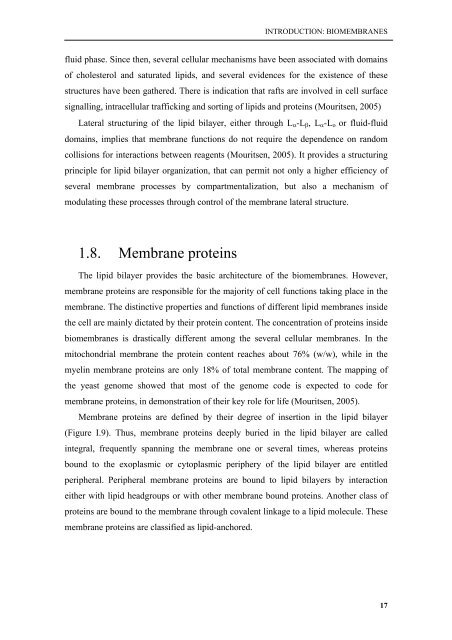Biophysical studies of membrane proteins/peptides. Interaction with ...
Biophysical studies of membrane proteins/peptides. Interaction with ...
Biophysical studies of membrane proteins/peptides. Interaction with ...
Create successful ePaper yourself
Turn your PDF publications into a flip-book with our unique Google optimized e-Paper software.
INTRODUCTION: BIOMEMBRANES<br />
fluid phase. Since then, several cellular mechanisms have been associated <strong>with</strong> domains<br />
<strong>of</strong> cholesterol and saturated lipids, and several evidences for the existence <strong>of</strong> these<br />
structures have been gathered. There is indication that rafts are involved in cell surface<br />
signalling, intracellular trafficking and sorting <strong>of</strong> lipids and <strong>proteins</strong> (Mouritsen, 2005)<br />
Lateral structuring <strong>of</strong> the lipid bilayer, either through L α -L β , L α -L o or fluid-fluid<br />
domains, implies that <strong>membrane</strong> functions do not require the dependence on random<br />
collisions for interactions between reagents (Mouritsen, 2005). It provides a structuring<br />
principle for lipid bilayer organization, that can permit not only a higher efficiency <strong>of</strong><br />
several <strong>membrane</strong> processes by compartmentalization, but also a mechanism <strong>of</strong><br />
modulating these processes through control <strong>of</strong> the <strong>membrane</strong> lateral structure.<br />
1.8. Membrane <strong>proteins</strong><br />
The lipid bilayer provides the basic architecture <strong>of</strong> the bio<strong>membrane</strong>s. However,<br />
<strong>membrane</strong> <strong>proteins</strong> are responsible for the majority <strong>of</strong> cell functions taking place in the<br />
<strong>membrane</strong>. The distinctive properties and functions <strong>of</strong> different lipid <strong>membrane</strong>s inside<br />
the cell are mainly dictated by their protein content. The concentration <strong>of</strong> <strong>proteins</strong> inside<br />
bio<strong>membrane</strong>s is drastically different among the several cellular <strong>membrane</strong>s. In the<br />
mitochondrial <strong>membrane</strong> the protein content reaches about 76% (w/w), while in the<br />
myelin <strong>membrane</strong> <strong>proteins</strong> are only 18% <strong>of</strong> total <strong>membrane</strong> content. The mapping <strong>of</strong><br />
the yeast genome showed that most <strong>of</strong> the genome code is expected to code for<br />
<strong>membrane</strong> <strong>proteins</strong>, in demonstration <strong>of</strong> their key role for life (Mouritsen, 2005).<br />
Membrane <strong>proteins</strong> are defined by their degree <strong>of</strong> insertion in the lipid bilayer<br />
(Figure I.9). Thus, <strong>membrane</strong> <strong>proteins</strong> deeply buried in the lipid bilayer are called<br />
integral, frequently spanning the <strong>membrane</strong> one or several times, whereas <strong>proteins</strong><br />
bound to the exoplasmic or cytoplasmic periphery <strong>of</strong> the lipid bilayer are entitled<br />
peripheral. Peripheral <strong>membrane</strong> <strong>proteins</strong> are bound to lipid bilayers by interaction<br />
either <strong>with</strong> lipid headgroups or <strong>with</strong> other <strong>membrane</strong> bound <strong>proteins</strong>. Another class <strong>of</strong><br />
<strong>proteins</strong> are bound to the <strong>membrane</strong> through covalent linkage to a lipid molecule. These<br />
<strong>membrane</strong> <strong>proteins</strong> are classified as lipid-anchored.<br />
17















